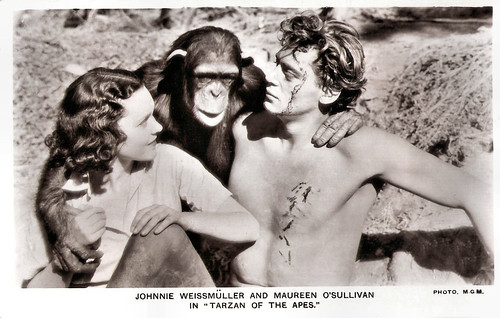
British postcard in the Picturegoer Series, no. 680. Photo: M.G.M. Publicity still for Tarzan the Ape Man (W. S. Van Dyke, 1932) with Maureen O'Sullivan, Cheeta and Johnny Weissmuller.
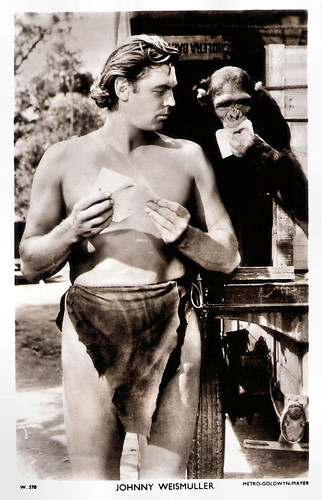
British postcard in the Picturegoer series, London, no. W 370. Photo: Metro-Goldwyn-Mayer.
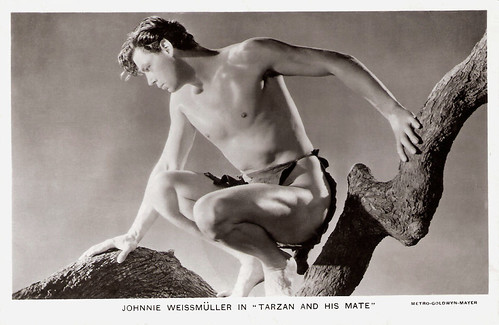
British postcard in the Picturegoer Series, London, no. 864. Photo: Metro-Goldwyn-Mayer. Publicity still for Tarzan and his Mate (W. S. Van Dyke, 1934).
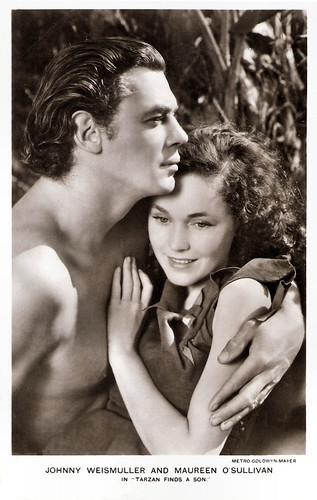
British postcard by Real Photograph, London, no. FS 208. Photo: Metro-Goldwyn-Mayer (MGM). Publicity still for Tarzan Finds A Son (Richard Thorpe, 1939) with Johnny Weissmuller and Maureen O'Sullivan.

British postcard by Milton, no. 147. Photo: Metro-Goldwyn-Mayer Pictures.
An adonis clad only in a fig leaf
In 1904, Johnny Weissmuller was born as Peter Johann Weißmüller in Freidorf, today Szabadfalva, in the district of the city of Timisoara in Romania, then a part of the Austro-Hungarian Empire. Weissmuller would later claim to have been born in Windber, Pennsylvania, probably to ensure his eligibility to compete as part of the US Olympic team. Weissmüller was one of two boys born to Petrus Weissmuller, a miner, and his wife Elisabeth Kersch, who were both Banat Swabians, an ethnic German population in Southeast Europe. The family arrived in the United States in 1905 when Johnny was 7 months old.
At age nine, young John Weissmüller contracted polio. He took up swimming on the advice of a doctor. After school, he worked as a bellhop and elevator operator at the Plaza Hotel in Chicago and trained for the Olympics with a swim coach at the Illinois Athletic Club. There he developed his revolutionary high-riding front crawl. He made his amateur debut in 1921, winning his first AAU race in the 50-yard freestyle.
From 1921 till 1929 Weismuller won every freestyle race he entered, from 100 yards to the half-mile. He won 67 world titles and 52 national titles. At the Olympic Games of 1924 and 1928, he won 5 Gold Medals and broke the record in each race. In 1929, Weissmuller signed a contract with BVD to be a model and representative. He travelled throughout the country doing swim shows, handing out leaflets promoting that brand of swimwear, signing autographs and going on the radio. That year he made his film debut in Glorifying the American Girl (John W. Harkrider, Millard Webb, 1929), appearing as an Adonis clad only in a fig leaf in the segment Loveland.
After great success with a jungle movie, MGM head Louis B. Mayer, via Irving Thalberg, optioned two of Edgar Rice Burroughs' Tarzan stories. Cyril Hume, working on the adaptation of Tarzan the Ape Man (W.S. Van Dyke, 1932), noticed Johnny Weissmuller swimming in the pool at his hotel and suggested him for the part of Tarzan. MGM got him released from his BVD contract by agreeing to pose for many of its female stars in BVD swimsuits. Weissmuller signed a seven-year contract with Metro-Goldwyn-Mayer
The studio billed him as "the only man in Hollywood who's natural in the flesh and can act without clothes". The film was an immediate box office and critical hit. And Weissmuller became an overnight international sensation. Seeing that he was wildly popular with girls, the studio told him to divorce his wife and paid her $10,000 to agree to it. Weissmuller starred in six Tarzan movies for MGM with actress Maureen O'Sullivan as Jane and Cheeta the Chimpanzee. The last three also included Johnny Sheffield as Boy.
After 1942, however, MGM had used up its options; it dropped the Tarzan series and Weissmuller, too. He then moved to RKO and made six more Tarzans with markedly reduced production values. Sheffield also appeared as Boy in the first five features for RKO. Brenda Joyce took over the role of Jane in Weissmuller's last four Tarzan movies (the first two RKO films had not featured Jane). Unlike MGM, RKO allowed Weissmuller to play other roles, though a three-picture contract with Pine-Thomas Productions led to only one film, Swamp Fire (William H. Pine, 1946), co-starring Virginia Grey and Buster Crabbe.
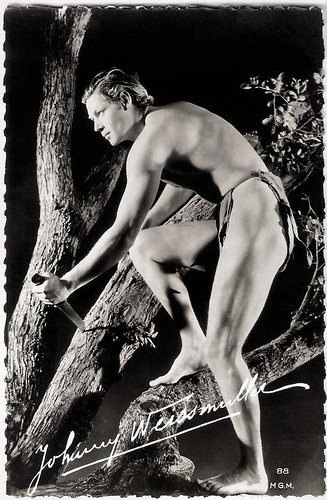
French postcard by Editions en Publications Cinematographiques, no. 88. Photo: Metro-Goldwyn-Mayer.
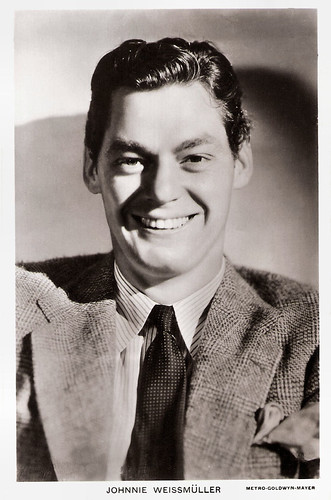
British postcard in the Picturegoer series, London, no. 668b. Photo: Metro-Goldwyn-Mayer.
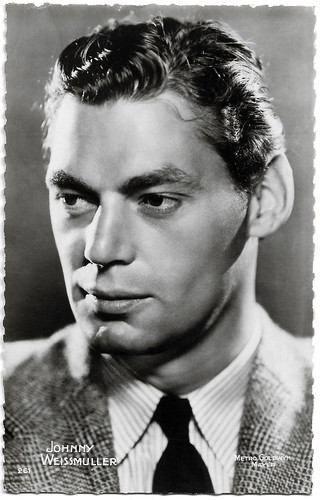
French postcard, no. 261. Photo: Metro-Goldwyn-Mayer (M.G.M).
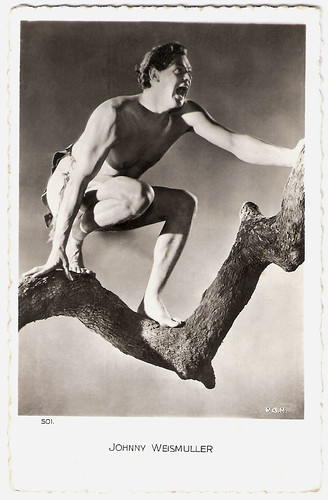
French postcard by Ed. Chantal, Paris no. 501. Photo: M.G.M.
International swimming hall of fame
After his Tarzan career was over, Johnny Weissmuller traded his loincloth costume for a slouch hat and safari suit for the role of Jungle Jim (William Berke, 1948), set in Africa. He made sixteen Jungle Jim films for Columbia between 1948 and 1954. Devil Goddess (Spencer G. Bennet, 1955) was the last entry in the series, as well as being Weissmuller's last feature film.
In 1955, he began production of the Jungle Jim television adventure series for Screen Gems, a film subsidiary of Columbia. The show produced only twenty-six episodes, which were subsequently played repeatedly on the network and syndicated television. Aside from his first screen appearance as Adonis in Glorifying the American Girl (1929) and the role of Johnny Duval in Swamp Fire (1946), Weissmuller played only three roles in films during the heyday of his Hollywood career: Tarzan, Jungle Jim, and himself. In the late 1950s after retiring from acting, Weissmuller moved back to Chicago and started a swimming pool company. He also lent his name to other business ventures, but did not have a great deal of success. He retired in 1965 and moved to Fort Lauderdale, Florida, where he was the Founding Chairman of the International Swimming Hall of Fame.
In 1970, he made a cameo appearance with his former Tarzan co-star Maureen O'Sullivan in the obscure comedy The Phynx (Lee H. Katzin, 1970). In 1973, he moved from Florida to Las Vegas where he was a greeter at the MGM Grand Hotel for a time. In 1974, he broke a hip and leg. While hospitalised he learned that, in spite of his strength and a lifelong daily regimen of swimming and exercise, he had a serious heart condition.
In 1976, he appeared for the last time in a film as a crewman who is fired by a movie mogul (Art Carney) in Won Ton Ton, the Dog Who Saved Hollywood (Michael Winner, 1976), and he also made his final public appearance in that year when he was inducted into the Body Building Guild Hall of Fame. In 1984, 'Big John' Weissmuller died in Acapulco, Mexico of pulmonary oedema after a series of strokes. At his request, a recording of his trademark Tarzan yell which he invented was played as his coffin was lowered into the ground.
He married five times and divorced four times. His wives were the band and club singer Bobbe Arnst (1931-1933), Mexican film star Lupe Velez (1933-1939), Beryl Scott (1939-1948), Ailene Gates (1948-1962) and Maria Bauman (1963-1984; his death). He had three children with Beryl Scott: actor Johnny Weissmuller Jr. (1940-2006), Wendy Anne (1942), and Heidi Elizabeth (1943-1962). His daughter Heidi died in a car crash. She had been driving south along the Pacific Coast Highway, on the way to return her husband and a friend to the naval base in San Diego where they were stationed. A few miles north of Laguna Beach, she fell asleep at the wheel and crashed. Heidi and her unborn child died. Her husband and his friend survived. According to his son, Weissmuller never got over the loss of his daughter and unborn grandchild.
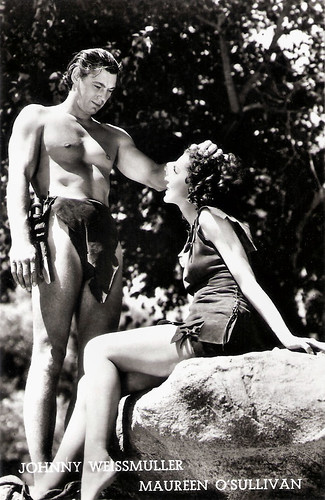
Belgian postcard. Photo: M.G.M. Johnny Weissmuller and Maureen O'Sullivan.

Vintage postcard.
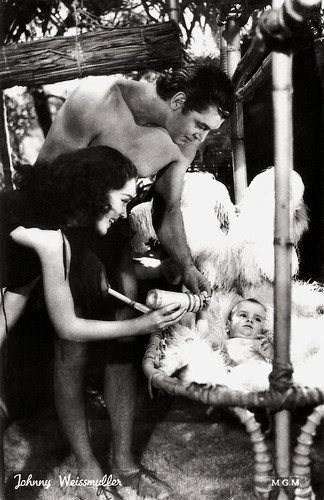
Vintage card. Photo: M.G.M. Publicity still for Tarzan Finds a Son! (Richard Thorpe, 1939) with Johnny Weissmuller and Maureen O'Sullivan.

Dutch postcard by Takken, Utrecht, no. 428. Photo: Metro-Goldwyn-Mayer Pictures. Johnny Weismüller and Johnny Sheffield in Tarzan Finds a Son (1939).

Dutch postcard by Film en Toneel, no. 3457.
Who did the yell in the Tarzan films?
According to Johnny Weissmuller he did the yell himself and he was inspired by the yodelling of his German neighbours, along with his own success in a yodelling contest he’d won as a boy.
However, MGM claimed to have enhanced the yell in post-production. Reportedly, they added and mixed the following:
1. A second track of Weismuller’s voice, amplified
2. A track of a hyena howl, played backwards
3. A note sung by a female opera soprano, with the speed varied to produce a fluttery sound
4. The growl of a dog
5. The bleat of a camel
6. The raspy note of a violin’s G-string being bowed.
And there are more stories...

Dutch postcard by Archief Film en Toneel, no. 3458. Photo: RKO Radio Films. Johnny Weissmuller. Collection: Carla Bosch.
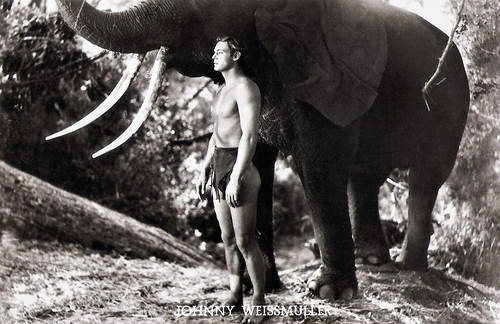
Dutch postcard, no. 751. Photo: M.G.M.
Trailer for Tarzan The Ape Man Trailer (1932) - with the yell. Source: Movieclips Trailer Vault (YouTube).
Sources: Ed Stephan (IMDb), Mental Floss, Wikipedia and IMDb.
No comments:
Post a Comment